The content of the article
Few people know that the often beautiful, small field flower Cichórium, sky-blue in color, hardly making its way through the dense soil of the roadsides, has to do with a tasty and healthy chicory drink.
The history of this plant is interesting and overgrown with legends. "Cichórium" is an Egyptian word that has been adopted and is used to define it in all European countries. Unraveled the healing properties of the Compositae plant 5,000 years ago. Egyptian people purposefully grew it for healing. In ancient Rome and Greece, chicory was added to the salad in the form of greens. The poets Publius Virgil, Quintus Horace, Publius Ovid, the encyclopaedist Pliny, in their writings mentioned chicory.Roman medical surgeon Claudius Galen defined him as "a friend of the liver."
Despite the bitter taste, the grass has found its application in all countries of the world. Earlier in northern Europe, whole fields were planted for livestock feed, and the Belgians still use young shoots for food.
The French tasted the taste of a coffee substitute when they found themselves in a blockade in 1808. The absence of the usual drink forced them to look for a substitute. After the situation had improved, the habit of adding chicory to coffee was firmly established. And Louisiana and New Orleans, have made this drink traditional for themselves. Despite the variety of coffees, this is their taste preference, fixed for centuries.
In Russia, the "golden root" began to gain popularity in the 19th century. It was grown for the preparation of the drink and as an additive to coffee. It was a good investment making a profit, since the demand for it was all year round.
Collecting and storing chicory
The area of growth is quite wide, since by its nature this plant is not whimsical and does not require fertile soils. His favorite habitats are rocky, sandy slopes and hills, steppe zones and beams.Large areas can be found in the European part of Russia, Ukraine, Belarus, the Caucasus, the Crimea.
Chicory cleaning takes place in autumn. This is the time when flowering is over, the leaves and flowers crumbled. Carefully dig up the root, thoroughly clean the unsuitable parts and small roots, wash and dry in the spread form under the sunlight for 5 days. Dried roots of all the rules can be stored in paper bags for up to three years.
To understand the benefits and harms of chicory, the composition of the plant was carefully studied, which included:
- Essential oil.
- Thiamine - takes care of the nervous system and keeps the heart functioning at the proper level.
- Inulin is a polymer of fructose, which is involved in metabolic processes in the body. Some of the unsplit matter takes with it cholesterol and toxins, and naturally removes cholesterol and toxins, and the part that has undergone transformation and has penetrated into the blood purifies the body of toxins inside. It can be called useful fiber.
- Carotene is a strong antioxidant. Cares about skin elasticity and youth. Excellent immunomodulator.
- Riboflavin (vitamin B2) is useful for the reproductive organs, important for the functioning of the thyroid gland, and also supports the health of hair, skin and nails.
- Glycoside intibin - widely applicable in the pharmaceutical industry. Able to expand blood vessels, eliminates tachycardia, reduces the amount of bad cholesterol. Smoothes cardiovascular disorders.
- Ascorbic acid (vitamin C) - supports the immune system, a good antioxidant, strengthens the walls of blood circulation vessels, normalizes muscle tone.
- Beauty vitamins of groups A, E, PP (nicotinic acid).
- Tannins - help the digestive tract work, remove from the body radionuclides, toxins and salts of heavy metals. They help the absorption of nutrients into the intestinal wall.
- Bitter and resinous substances.
- Pectin - gives a feeling of fullness.
- Choline is a unique natural remedy of nootropic action. Regulates brain metabolism. Develops cerebral (cerebral) blood flow.
- Trace elements Potassium, iron, manganese, sodium, phosphorus.
- Fats, proteins, salts.
- Intibin - used in traditional medicine as a means of sedative nature,balancing nervous system. Fights tachycardia and is a vasodilator.
The benefits of chicory for the human body
- It is characterized by astringent properties due to the presence in the composition of tannins and bitterness.
- Decreased blood sugar. Monitors and normalizes its level.
- Sedative effect. It contains many components that are invaluable for the functioning of the nervous system.
- Immunomodulatory, due to the rich composition of vitamins and minerals, antioxidants.
- Wound healing.
- Choleretic. Excellent stimulator of liver function. Removes toxins from it.
- Diuretic.
- Gives a good impetus to the digestive system.
- Good antiseptic. May relieve inflammation.
- Stimulates the growth of bone tissue.
- Promotes calcium absorption.
- In case of catarrhal diseases it can be an antipyretic and diaphoretic agent.
- Intensively expels slags, radionuclides and salts of heavy metals of their body.
- Normalizes heart function and heart rate.
- Improves the resistance of the bronchial tree, ureters.
The list of diseases that are due to chicory:
- Hypertension - increase in blood pressure.
- Neurosis.
- Insomnia
- Hyperacid gastritis. Chronic inflammation of the stomach. Increased acidity.
- Kidney disease (nephritis).
- Anemia (anemia).
- Lack of vitamins, leading to loosening of the gums (scurvy).
- Inflammation of the small intestine (enteritis).
- Violation of microflora in the intestine (dysbacteriosis)
- Chronic constipation.
- Weakness, fatigue.
- Increased sweating.
- Inflammatory process in the bladder (cystitis).
- Education in the gallbladder and duct stones.
- Used in spleen disease.
- Chronic liver disease of a destructive nature - cirrhosis.
- Inflammation of the liver (hepatitis)
- Inflammation of the joints (arthritis).
- Inflammatory process in the colon (colitis).
- Inflammation of the gallbladder wall (cholecystitis).
The above diseases can be treated using a variety of dosage forms (decoctions, drinks, tinctures).
It is also effective to apply chicory externally (lotions, wiping, poultices, baths, dressings):
- Purulent wounds, ulcers.
- Itching, bubbly rash (eczema).
- Painful purulent inflammation (boils).
- Food allergies in children (diathesis).
- Inflammation of the lymph nodes.
A wide range of actions will not disregard any system of the body. Support and strengthen the heart, liver, kidneys, blood.
A valuable factor is the ability to use this healing root for people suffering from diabetes. Polysaccharide fully, naturally replaces sugar.
Chicory is useful and necessary for pregnant women. It is rich in vitamins, trace elements. Cares about the preservation of calcium in the body. Perfectly tones, removes excess fluid. Helps to cope with nausea and heartburn. Great antioxidant.
Beauty and health of hair and skin
Nerves, stress, polluted atmosphere, postpone the imprint of fatigue on the skin and give a painful look to the hair. In cosmetology, shampoos, conditioners, masks often include extracts from the roots. With enhanced hair loss, seborrhea, at home, decoctions from the collection are used to rinse hair and relieve inflammation from the skin.
Chicory juice can be added to the cream and face masks - this will speed up the healing process of pustular eruptions and acne.
Nutritionists recommend!
The caloric content of chicory per 100 g - 21 kcal.To get rid of extra pounds, you must adhere to certain rules:
- Take on an empty stomach, without additives in the form of milk and sugar.
- During the day, take 2-3 times.
- Finish the day with a cup of chicory.
- To reduce the use of excessively high-calorie foods.
Inulin is a prebiotic. Its usefulness is verified and confirmed by microbiologists. Long-term use is completely safe. For people who want to reduce the size of their clothes in a couple of sizes, it is a good helper, as it creates a favorable environment for the intestinal microflora, and also regulates lipid metabolism. An important point is the ability to regulate appetite, to create a feeling of saturation. Regulates carbohydrate metabolism.
In what cases is not recommended to take chicory
- Neurosis.
- Bronchitis.
- Gastritis.
- Bronchial asthma.
- Hemorrhoids.
- Individual non-perception.
- Children up to 3 years.
- Vitamin C is an allergen. Allergy sufferers are at risk.
- Varicose veins
It is not recommended for lactating mothers, as chicory through the mother’s milk can arouse the nervous system of the infant and also cause allergies.
Housekeeping Note: Recipes for All Occasions
- Brew tea. Chicory root is washed and dried. Roast. Rub in dust. 1 teaspoon of powder is poured with a glass of boiling water and cooked for another 5 minutes. Give a little brew and you can enjoy tea with the addition of milk and honey to taste.
- Chicory juice. Squeezed from fresh leaves of plants. Mix with milk and use 15 ml three times a day for one and a half months.
- Collection recommended for stones in the gall bladder and ducts. Dandelion and chicory roots are taken in equal proportions. To them compose a leaf of mint, cakes, trifoli (all components of 50 g). From the total take 2 tbsp. spoons collection, pour 0, 5 liters of boiling water. Insist a few hours. Distribute reception for two days.
- Broth outside. 20 g of dry collection of herbs and roots diluted with 2 cups boiling water. Insist 10 min. Use for instillation of eyes affected by conjunctivitis and poultices - to relieve pain in the joints.
- Tincture for the treatment of wound surfaces.10g of roots pour alcohol (40 ml). Week insist in a dark place. Used for rubbing the surface of the skin.
- Anti-cellulite therapy. Shredded root 2 tbsp. spoon mixed with 1 cup boiling water. About an hour brew in a thermos. The contents are poured into a bath and immersed for 25 minutes. Repeat every other day for 21 days.
- Broth for the intensity of hair growth. Grass and roots are filled with boiling water. At 30 g add 4 cups. Cook for 30 minutes. Insist 6 hours. Flow through gauze. The finished medicine is rubbed into the hair roots. Allow to soak for 10 minutes and rinse under running water.
Video: the benefits and harm of chicory

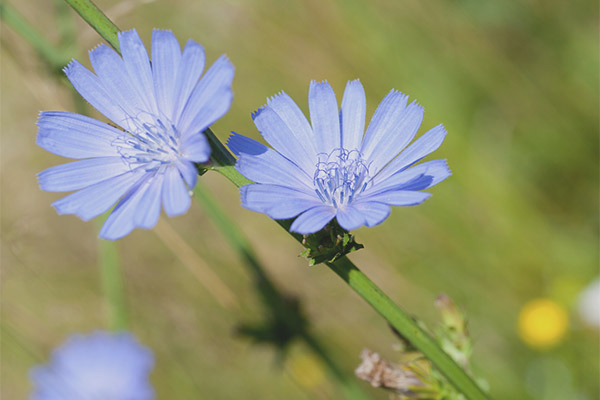
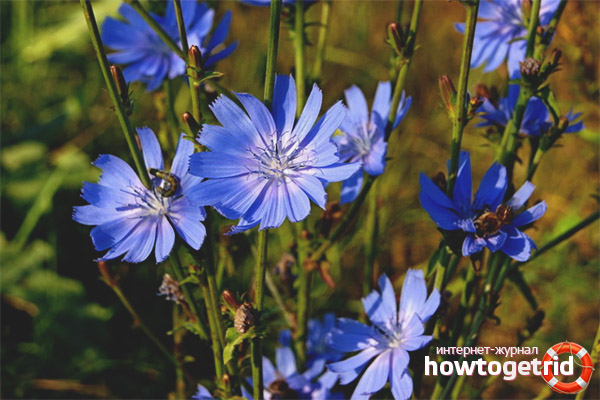

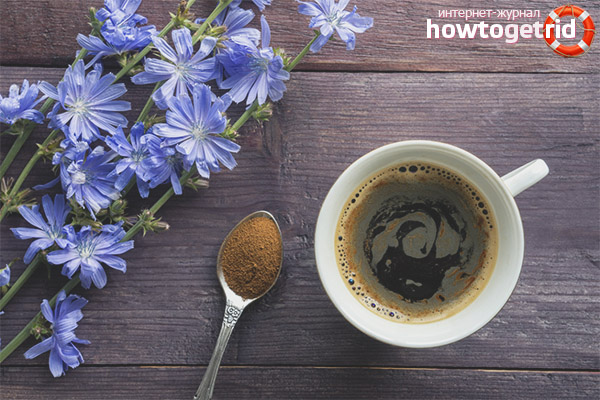



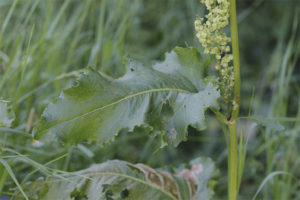
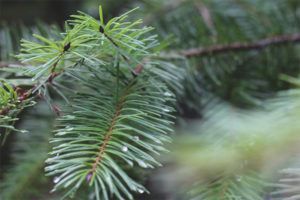
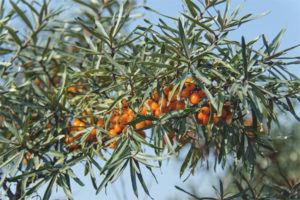

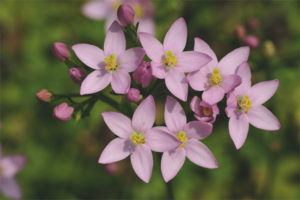
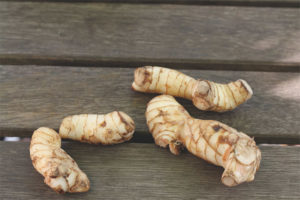
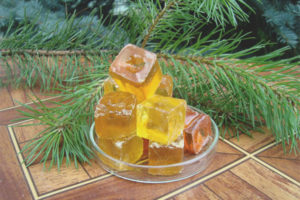
To send